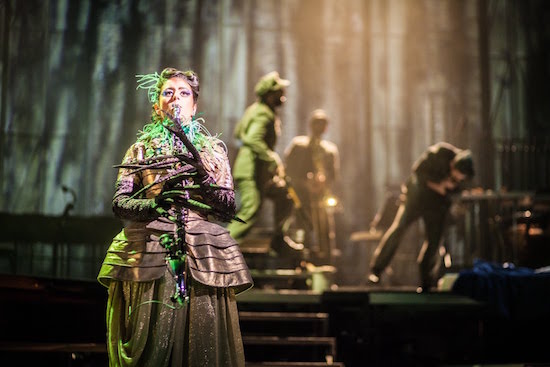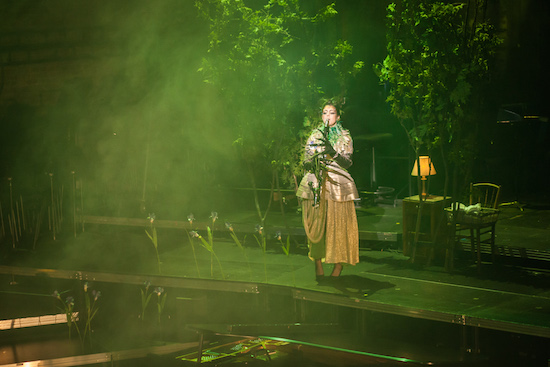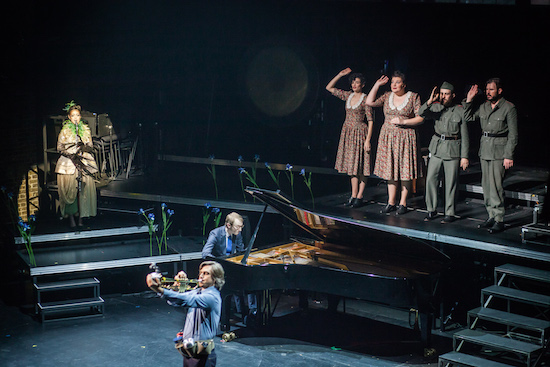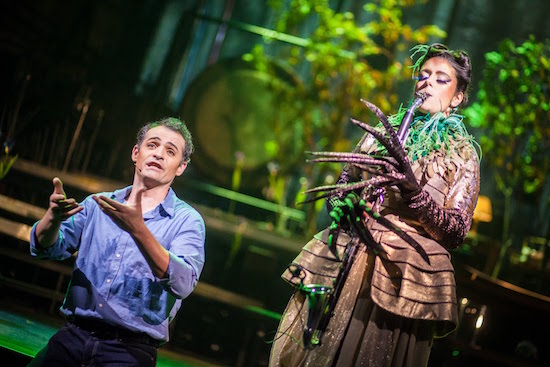What do we mean when we say ‘opera’? Full-bodied women in viking helmets bellowing throatily with arms outstretched? Stuffed tuxedos in over-priced boxes braying bravos with champagne flowing? An out-dated, over-indulged extravagance for rich arses on plush seats? For indie band Ravioli Me Away, whose "opera", The View From Behind The Futuristic Rose Trellis comes to Block Universe performance art festival in London later this month, the word seems to mean "grand themes about love and death and life", some sense of the "tragi-comic", a certain "seriousness", as members Alice Theobold, Sian Dorrer, and Rosie Ridgway put it in a trailer for the work made by Wysing Arts Centre.
You might recall a similarly fuzzy logic to interviews with The Knife when their own opera with PlanningToRock and Hotel Pro Forma, Tomorrow, In a Year, was produced a decade ago. "I didn’t have any knowledge of opera," the group’s Karin Dreijer Andersson told The Guardian. It was just "a piece of work," confirmed her brother Olof.
Interviewing Laurie Anderson around the same time, she recalled to me the creative foment of late 70s downtown New York. "At one point we were all working on operas," she said. "We called them that. Everybody was doing it and we didn’t know what it was."
So why say "opera"? What are people trying to evoke here?
My guess: something big. A kind of everything-at-once-ness. Maximalism as method.
Call it the legacy of the Wagnerian Gesamtkunstwerk. Richard Wagner once pledged to erect a purpose-built theatre on the banks of the Rhine for the sole purpose of staging just one performance of his four-part opera cycle about the death of the gods and the coming age of man. After the show, he would burn down the theatre and scatter the ashes into the water.
He never quite got round to that. But the theatre he did build in Bayreuth, with its darkened house and parterre seats, electric lights and moving stage flats, did more or less invent the conditions of cinema, decades before the technology was invented. The Bayreuth opera house was a theatrical engine – complete with smoke effects from a real locomotive – a mass media machine, exploiting technical illusion and psychoacoustic effects to operate directly on the senses of its audience. For Wagner, it was intended as a direct incitement to revolution.
A few decades later, in the first quarter of the twentieth century, the Russian synaesthete, Alexander Scriabin imagined a vast mystery play, combining extravagant lighting, perfumes, orchestral music and pyrotechnics, in the foothills of the Himalayas. He called it the Mysterium and imagined it bringing about a new age of humanity.
Then Edgard Varèse, the Parisian "organiser of sound", spent decades in the mid-twentieth century agonising over a vast multimedia work called variously L’Astronome, L’Espace, or The One-All-Alone. He commissioned libretti from some of the greatest poets of his day, like Malraux, Desnos, and Artaud. It was to combine Native American mythology with sci-fi imagery, electronic music, spatialised sound and international telecom networks to link a distributed performance on three continents. It remained unfinished, fragmentary, upon the composer’s death in 1965.
All of which is mere child’s play, no more than a palette-opening amuse bouche before the epic smörgåsbord of LICHT. A seven opera cycle by Karlheinz Stockhausen amounting to some twenty-nine hours of music in which orchestras, choirs of adults and children, African percussion ensembles, multiple soloists, dazzling electronics in eight-channel surround sound, and – at one point – a string quartet distributed across four different airborne helicopters unite at the outer fringes of the universe to deliver a cosmic struggle so grandiose and complex as to defy description, combining as it does elements of Judeo-Christian and Vedic spirituality, Renaissance masque, Noh theatre, and a bizarre theosophical text supposedly channeled directly from celestial beings called the Book of Urantia. When Stockhausen goes big, he does not piss about.

The origins of LICHT are almost as strange as the work itself. After all, for a composer who spent the 50s writing precisely controlled, almost mathematical works for layered sine tones and machine-like virtuosi, the switch to spiritualist space opera represented a curious sideways lunge. Like a butterfly in flowing, multi-coloured robes emerging from the shell of a buttoned-up, dodecaphonic worm, the Stockhausen of the 1970s was a dreamer awakening.
In the spring of 1968, Karlheinz Stockhausen experienced something that might equally be described as nervous breakdown or epiphany. On the 6th of May, amidst continuing unrest in Germany following the attempted assassination of student leader Rudi Dutschke, Stockhausen left Cologne to seek refuge in the small village of Kürten in North Rhine-Westphalia. The day before, Ulrike Meinhof had published her famous column in Konkret on the need to move "from protest to resistance". Everything was kicking off.
At his retreat in Kürten, Stockhausen had expected to find his wife waiting for him. Instead, he was met by a note, explaining her reasons for leaving him. The discovery of this note prompted the composer to embark upon an intensive week-long hunger strike, during which he entered a sort of altered state of being and awareness. Meditating intensely, scarcely moving, sleeping or even thinking because all conceivable paths of thoughts seemed to lead inexorably towards death; he was beset by visions – "sound visions" – of an apocalypse soon to come.
What emerged from that week in Kürten was a markedly different composer from the former Die Reihe editor who had championed a strict integral serialism in the 50s and early 60s. Now Stockhausen spoke of an "intuitive music" – or what he would later call "music from utopia". One such intuitive composition, consisting of just a few lines of text instructions, begins, "Imagine you are a higher being, which comes from another star …"
This seems to be more or less precisely how Stockhausen had taken to imagining himself. In a series of "crazy dreams", Stockhausen learnt "that not only did I come from Sirius itself, but that, in fact, I completed my musical education there." As he explained in an interview with Mya Tannenbaum published in book form in 1987, the discovery led him directly to the composition of a new work called Sirius, a fantastical music drama that the composer would dedicate to the "American pioneers on earth and in space".

Sirius opens with a sound familiar to all fans of British science fiction television: flying saucers coming down to earth via the medium of the frequency shifted oscillator whirl of an EMS Synthi 100 analogue synthesizer. From these spacecraft descend four soloists, messengers from the Dog Star, here to explain their philosophy of music. The soloists are typically dressed in glittery space disco outfits in the manner of Night Flight to Venus-era Boney M. They don’t say "Take me to your leader", but we do get a baritone "We greet you, Earthlings" recalling Marvin the Martian, Daffy Duck’s extraterrestrial foil from the Looney Tunes cartoons. First performed at the opening of the Albert Einstein Spacearium in Washington, DC, on 15 July 1976, the work marked the composer’s decisive turn towards music theatre.
It was in Japan, ensconced in another dome-like venue of space-age proportions, that the first inkling of LICHT itself came to Stockhausen. In 1970, the composer was elected avatar of German music at the Osaka Expo, channelling his music through seven rings of loudspeakers in a vast geodesic dome surrounded by landscaped gardens.While there, he became fascinated by the country’s traditional court music and the first music composed for the piece was a work for gagaku orchestra and dancers, performed on its own at the National Theatre in Tokyo before being subsumed into LICHT‘s second day.
In the end, LICHT would consume over twenty-five years of Stockhausen’s life, being his sole compositional output from 1977 to 2003. But for all that, it remains remarkably consistent, with each element tied together by a small number of what the composer called "super-formula", melodic DNA strands which are variously expanded, extrapolated, and projected to determine all the minute details of the work as a whole, from the microscopic details of articulation and phrasing in a given passage to the overall form and structure of the whole opera cycle. As Tim Souster pointed out in a piece for the London Review Of Books a few years back, Stockhausen may have talked a lot of turkey about freedom and intuition after ‘68, but he could "never actually relinquish control."

Writer and composer Robin Maconie, Stockhausen’s former pupil, once speculated that maybe "LICHT is not meant for our time after all, but, in the words of Claude Levi-Strauss, for those archeologists of the future coming from another planet, who in trying to decipher human script ‘would soon discover that a whole category of books – music – did not fit the usual pattern.’" Certainly the composer’s sights seemed, in later life, increasingly to be set beyond the terrestrial plane. The world as it is was just too small for Karlheinz Stockhausen. He had to go out there and build his own.
Stockhausen’s Donnerstag Aus Licht takes place at London’s Southbank Centre this May – for tickets and more information, go here


